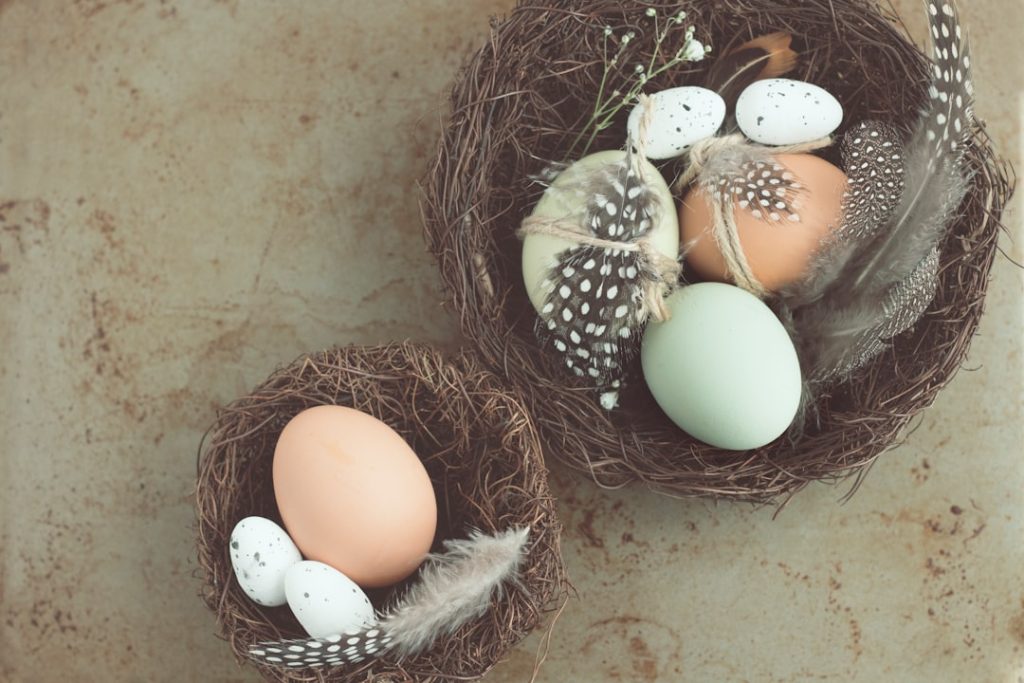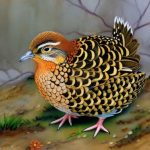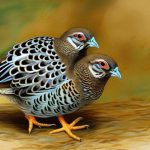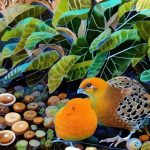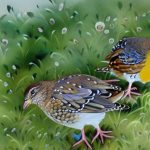Button quail, also known as Chinese painted quail, are small, ground-dwelling birds that are popular among aviculturists for their charming appearance and interesting behaviors. Breeding button quail can be a rewarding experience for bird enthusiasts, as these birds are relatively easy to care for and breed in captivity. In this article, we will explore the natural breeding behavior of button quail, the ideal breeding environment, pairing and mating behavior, egg incubation and care, as well as caring for chicks and juveniles. By understanding the intricacies of button quail breeding, aviculturists can successfully breed and raise healthy button quail in a natural and stress-free environment.
Button quail are native to Southeast Asia and are known for their small size, colorful plumage, and distinctive call. In the wild, button quail are ground-dwelling birds that inhabit grasslands, scrublands, and agricultural areas. They are social birds that form monogamous pairs during the breeding season and are known for their elaborate courtship displays. In captivity, button quail can be bred in a naturalistic setting that mimics their natural habitat, allowing them to exhibit their natural behaviors and breeding instincts. By providing the right environment and understanding their natural breeding behavior, aviculturists can create a successful breeding program for button quail.
Table of Contents
- 1 Understanding the Natural Breeding Behavior of Button Quail
- 2 Creating the Ideal Breeding Environment for Button Quail
- 3 Pairing and Mating Behavior of Button Quail
- 4 Egg Incubation and Care
- 5 Caring for Chicks and Juveniles
- 6 Tips for Successful Natural Breeding of Button Quail
- 7 FAQs
- 7.1 What is natural breeding for button quail?
- 7.2 What are the requirements for natural breeding of button quail?
- 7.3 How do button quail courtship and mating behaviors occur in natural breeding?
- 7.4 What is the incubation period for button quail eggs in natural breeding?
- 7.5 What should be done after the button quail chicks hatch in natural breeding?
Key Takeaways
- Button quail breeding is a rewarding hobby that requires understanding the natural breeding behavior of these birds.
- Creating the ideal breeding environment for button quail involves providing the right nesting materials and a suitable habitat.
- Pairing and mating behavior of button quail involves observing the courtship rituals and ensuring a balanced male to female ratio.
- Egg incubation and care is crucial for successful breeding, requiring proper temperature and humidity levels.
- Caring for chicks and juveniles involves providing a balanced diet and a safe, stress-free environment for their growth and development.
In the wild, button quail are known for their monogamous mating behavior, where a male and female form a pair bond during the breeding season. The courtship display of button quail is a sight to behold, with the male performing elaborate dances and vocalizations to attract a mate. Once a pair bond is formed, the male will continue to court the female by offering her food and performing intricate displays to reinforce their bond. Understanding these natural behaviors is crucial for successful breeding in captivity, as it allows aviculturists to create an environment that encourages pair bonding and mating.
Button quail are also known for their secretive nesting behavior, where the female will seek out a secluded spot on the ground to build a nest and lay her eggs. In captivity, it is important to provide suitable nesting materials such as grass, hay, or shredded paper to encourage the female to build a nest. By observing the natural breeding behavior of button quail, aviculturists can create an environment that supports their natural instincts and encourages successful breeding. Providing a stress-free environment with ample hiding spots and suitable nesting materials will help button quail feel secure and comfortable enough to breed successfully.
Creating the ideal breeding environment for button quail is essential for successful breeding in captivity. Button quail thrive in spacious aviaries or large cages with plenty of ground space for foraging and dust bathing. The aviary should be furnished with natural materials such as branches, rocks, and plants to provide enrichment and mimic their natural habitat. Providing hiding spots such as dense vegetation or shelters will help button quail feel secure and reduce stress, which is crucial for successful breeding.
In addition to a spacious and enriched environment, it is important to provide suitable nesting materials for button quail to build their nests. This can include grass, hay, shredded paper, or even artificial nesting materials designed specifically for small birds. The nesting area should be secluded and away from high traffic areas to provide privacy for the breeding pair. By creating a naturalistic environment that supports their natural behaviors, aviculturists can encourage successful breeding and nesting behavior in button quail.
Pairing and mating behavior in button quail is an important aspect of successful breeding in captivity. In the wild, button quail form monogamous pairs during the breeding season, with the male performing elaborate courtship displays to attract a mate. In captivity, it is important to provide ample space and suitable hiding spots for button quail to form pair bonds and engage in courtship behavior. Providing a stress-free environment with minimal disturbances will encourage natural mating behavior in button quail.
Once a pair bond is formed, the male will continue to court the female by offering her food and performing intricate displays to reinforce their bond. It is important to observe the pair closely to ensure that mating behavior is occurring regularly. If mating behavior is not observed, it may be necessary to provide additional hiding spots or rearrange the aviary to encourage pair bonding and mating. By understanding the natural pairing and mating behavior of button quail, aviculturists can create an environment that supports successful breeding and reproduction.
Egg Incubation and Care
After successful mating, female button quail will lay eggs in a secluded nest on the ground. It is important to provide suitable nesting materials such as grass or hay to encourage the female to build a nest and lay her eggs. Once the eggs are laid, it is crucial to monitor the nest closely to ensure that the eggs are being incubated properly. If the female is not incubating the eggs consistently, it may be necessary to remove the eggs and incubate them artificially using an incubator.
Button quail eggs typically have an incubation period of 16-18 days, during which they require consistent temperature and humidity levels for successful hatching. It is important to carefully monitor the temperature and humidity levels in the incubator to ensure optimal conditions for egg development. Once the eggs hatch, it is important to provide a warm and safe environment for the chicks to thrive. By understanding the intricacies of egg incubation and care, aviculturists can successfully hatch and raise healthy button quail chicks.
Caring for Chicks and Juveniles

Caring for button quail chicks and juveniles requires attention to detail and proper husbandry practices. Newly hatched chicks are fragile and require a warm and safe environment to thrive. It is important to provide a brooder with a heat source such as a heat lamp or heating pad to maintain optimal temperature for the chicks. Additionally, providing suitable bedding material such as paper towels or pine shavings will help keep the brooder clean and hygienic for the chicks.
Feeding button quail chicks requires specialized chick starter feed that is high in protein and essential nutrients for growth and development. It is important to provide fresh water at all times and monitor the chicks closely for any signs of illness or distress. As the chicks grow into juveniles, it is important to gradually introduce them to a balanced diet of seeds, grains, and fresh greens to support their nutritional needs. By providing proper care and nutrition, aviculturists can raise healthy button quail chicks into thriving juveniles.
Successful natural breeding of button quail requires attention to detail and understanding of their natural behaviors. Providing a spacious aviary with ample hiding spots and suitable nesting materials will encourage pair bonding and mating behavior in button quail. It is important to create a stress-free environment with minimal disturbances to support successful breeding.
Monitoring the nesting behavior of female button quail closely will help ensure that eggs are being incubated properly. If necessary, eggs can be artificially incubated using an incubator to increase hatch rates. Caring for button quail chicks requires attention to detail and proper husbandry practices to ensure that they thrive into healthy juveniles.
In conclusion, breeding button quail can be a rewarding experience for bird enthusiasts who are passionate about aviculture. By understanding their natural breeding behavior and creating an ideal breeding environment, aviculturists can successfully breed healthy button quail in captivity. With proper care and attention to detail, button quail can thrive and reproduce in a naturalistic setting that supports their natural instincts and behaviors.
If you’re interested in breeding button quail naturally, you may also want to check out an article on Poultry Wizard about creating a portable chicken coop for easy relocation and management. This article provides valuable insights into designing a coop that can be moved around your property, which could be beneficial for managing the breeding environment for button quail. You can find the article here.
FAQs
Natural breeding for button quail refers to the process of allowing the quail to breed and reproduce on their own, without human intervention such as artificial insemination or incubation.
To facilitate natural breeding, button quail require a suitable environment with proper nesting materials, a balanced diet, and appropriate lighting and temperature conditions. It is also important to provide enough space for the quail to engage in courtship and mating behaviors.
During courtship, male button quail will display their feathers and perform a “bobbing” dance to attract females. Once a pair has formed, mating occurs through a brief copulation process. The female will then lay eggs in a nest prepared by both the male and female.
The incubation period for button quail eggs is approximately 16-18 days. During this time, the female quail will incubate the eggs, occasionally turning them to ensure proper development.
After hatching, the button quail chicks should be left with the parents to be raised naturally. The parents will provide warmth, protection, and food for the chicks. It is important to provide a safe and secure environment for the family to thrive.
Meet Walter, the feathered-friend fanatic of Florida! Nestled in the sunshine state, Walter struts through life with his feathered companions, clucking his way to happiness. With a coop that’s fancier than a five-star hotel, he’s the Don Juan of the chicken world. When he’s not teaching his hens to do the cha-cha, you’ll find him in a heated debate with his prized rooster, Sir Clucks-a-Lot. Walter’s poultry passion is no yolk; he’s the sunny-side-up guy you never knew you needed in your flock of friends!

